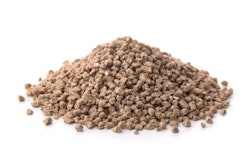
A ranking of 2019’s top 10 best-performing Feed Strategy magazine articles
Every year, I produce a roundup of the top-ranking Feed Strategy magazine articles. And every year, you can determine which critical issues were top of mind with our readers — and in the global feed industry — by the topics or themes that saw the most traffic.
As antibiotics increasingly are eliminated from animal production, three of the top performing articles (No. 1, 4 and 9) focused on how to reduce antibiotics from animal feed production and offered a look at feed additive alternatives.
In 2019, unsurprisingly, African swine fever (ASF) and anything related to biosecurity and feed safety performed very well (No. 3 & 5). Taking it a step beyond the production implications, the ripple effects of ASF on the world’s protein markets and consumer preferences also resonated with our audience (No. 6 & 10).
The rest? A mixed bag; however, the popularity of the No. 2 slot, the Top Feed Companies special report, wasn’t a surprise at all because it is a top performer year-round in the publication and on our website.
Hope you enjoy revisiting these articles and all the best in 2020!
Feed Strategy magazine’s Top 10 articles of 2019
Note: For the best experience in accessing 2019’s Top 10 Feed Strategy articles, please make sure you are registered and logged in to FeedStrategy.com.
Leading our list of 2019 headlines, contributing editor Ioannis Mavromichalis’ article from the April issue outlines four feed additive categories shown to achieve positive results in place of antibiotic growth promoters (AGPs) in animal feed. While no one additive is a true replacement for AGPs, Mavromachalis feels these four replicate their end result, if not, their mode of action.
Year after year, WATT Global Media’s exclusive Top Companies reports rank among the top-performing features across all of our publications and 2018’s Top Feed Companies report was no exception. Tracking compound feed production volumes of more than 1 million metric tons in a calendar year, the report, which ran in the September issue, ranked the leading global producers in its seventh edition. The data is drawn from our Top Feed Companies database, which includes a deeper dive into more than 200 feed producers worldwide.
2019 will be marked by the major disruption ASF dealt to Chinese and Southeast Asian swine production — as well as shifts in global protein markets. In the May 2019 issue, I dug into the impacts the disease will have on feed production and the role feed biosecurity plays in mitigating and preventing the spread of the virus.
European feed producers have been working without AGPs since 2006. In Mavromichalis’ view, the industry now follows a more holistic approach, viewing antibiotic usage reductions as “a goal to be achieved gradually by a complete overhaul of the whole industry.” In the January issue, he presents 12 lessons he’s learned along the way, citing that there’s no need to “reinvent the wheel” as others embrace antibiotic-free production.
Looking outside of Asia, in the September issue, contributor Kasey Culliney explored how European swine industry stakeholders ramped up biosecurity programs across borders and the entire supply chain to take responsibility for their role in ASF risk mitigation.
In Feed Strategy’s May issue, Culliney explored the evolution of the Chinese consumers’ protein preferences and how ASF may usher in a new era for proteins beyond pork.
Last year, I spent a day at broiler breeder Aviagen’s Athens, Alabama, feed mill, known as the “only dedicated biosecure feed mill in the United States.” Summing up their pathogen-free efforts and the feed mill procedures that make it a reality, I wrote a profile featured in our January 2019 issue.
Much of our evergreen, practical content is known to perform well and Mavromichalis’ examination and analysis of pig nutrition programs was no exception. Here, he notes that feeding piglets requires attention not only in feed design but also in the application of a successful feeding program.
In the April issue, contributor Zoe Kay examined how gene products, such as bacteriophages, used as antibiotics alternatives, show potential in fight against antimicrobial resistance.
Rounding out our Top 10 list, my Poultry Outlook special report gathered prognostications from many sources working in the poultry and poultry feed production. Did they pan out? Read (or reread) the article and find out.

















